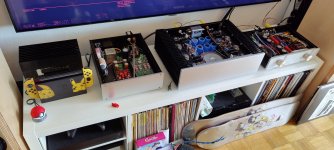I agree and it is both easy and repeatable. I think the "theoretically correct" test is to terminate the input in the highest anticipated source impedance. Then you get contributions from both voltage noise and current noise. Typically, this would not be much different than the short unless the source impedance is very high or there is an amplifier design issue.A fairer test would be with shorted input.
Jan
Very faint hum in the right channel with inputs open at maximum volume with my ear as close to the woofer as possible, silence with inputs shorted. Mind you, I never designed it to be silent with open inputs.
I made a split preamp, it has a tube gain stage before the volume pot therefore this test puts it at a slight disadvantage. I have 92db w speakers and can barely make out some hiss with my ear pressed to the tweeter. 110db s/n at 1 watt output is the result.
Suppose you have a line input with a resistor to ground, like they usually have. In normal use, the bigger the resistor, the less thermal noise current sqrt(4kTB/R) (where B is bandwidth) it injects into the signal source and the less bass loss it gives when the source has an output coupling capacitor. With open input, the bigger the resistor, the greater the thermal noise voltage sqrt(4kTBR) that develops across it and the greater the noise voltage caused by the input noise current of the rest of the circuit.
By the way, with shorted input, having the volume control at -6.02 dB may be worse than having it at maximum volume. When the line input goes straight into a selector switch and the volume potmeter, volume halfway gives maximum noise with shorted input.
By the way, with shorted input, having the volume control at -6.02 dB may be worse than having it at maximum volume. When the line input goes straight into a selector switch and the volume potmeter, volume halfway gives maximum noise with shorted input.
My amplifier in use is an LM3886 chip supplied power from a split 12V power supply. The amplifier module itself has two 2200uF electrolytic capacitors while the power supply has two 3300uF capacitors. This means, a 5500uF is used for each channel as a reservoir capacitance. Although, this system is a poor candidate compared to what is met here in this forum, in my opinion, it is still dangerous for me to use all the volume with open inputs and keep my ears against the speaker grill. The speakers are 12" and there is also a powerful compression tweeter. Since, I live in an area where neighbours are convinced they can break any law, I dare not do such a test. Electronics can fail and can be replaced or substituted with something else, but eardrums cannot, and I still need my hearing.
Last edited:
Its easy to estimate, depending on resistor value, elec cap ESR and f.47,000 uf x2, fed by resistors; I can't think of much noise getting through them.
As an example, if your elec has 0.2ohms ESR and you use 0.2 ohms series R, half of the input junk will get to the output at 1kHz.
Jan
The results so far have been better than I expected: most systems are silent. The test was not too hard. I suspect that non-silent systems may be under-reported (a classic case of sample bias).
jacques antoine - I am neglecting mechanical hum. My toroid hums briefly for 1-2 seconds before settling down.
edbarx - Use caution.
Ed
jacques antoine - I am neglecting mechanical hum. My toroid hums briefly for 1-2 seconds before settling down.
edbarx - Use caution.
Ed
I’m convinced my system has negative silence. When the music stops my ears ring.
Seriously though, I upgraded my speakers to a Econowave design at 96db, this had a hiss. So, I changed out my pre-amp and it’s quiet again, just a little hiss with my ear dangerously close to the horn with 500W behind it.
Seriously though, I upgraded my speakers to a Econowave design at 96db, this had a hiss. So, I changed out my pre-amp and it’s quiet again, just a little hiss with my ear dangerously close to the horn with 500W behind it.
I can hear slight noise. In fairness, mine is an active powered system feeding high sensitivity horn speakers. On the plus side, all the line levels are either digital or balanced. Also the system is used for home listening at reasonable levels. I've never worked pro but I suspect it'd be nearly impossible to not have slight hiss at the gains they run stuff at. That's my occasional observations at PA set-ups when the room is quiet.
One factor guaranteed to produce absolute silence is my mentioning the brand name of most of my electronics: "Behringer." 🤔
One factor guaranteed to produce absolute silence is my mentioning the brand name of most of my electronics: "Behringer." 🤔
It's a fair test if you only have digital inputs. 😉Open input is not really a fair test.
Jan
What? My tweeter amps have 6dB gain. It's an engineering decision I made to eliminate noise. Careful gain structure is critical to the success of all wide dynamic range analog systems.All amplifiers should have a gain of 30-35dB.
Ed
The question you are really asking is "Who has a poorly engineered sound system?".
Last edited:
Slightly more precise evaluation method.

With additional 10 dB gain, wideband output noise would be 160 uV. That would produce 3.2 nW / 8Ω or 170 dB below 1W. No way to hear anything even with some 110 dB/W horns. 🙂
With additional 10 dB gain, wideband output noise would be 160 uV. That would produce 3.2 nW / 8Ω or 170 dB below 1W. No way to hear anything even with some 110 dB/W horns. 🙂
- Home
- Amplifiers
- Solid State
- Is your system silent?

